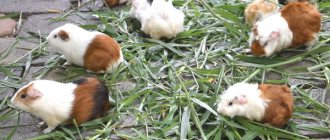- home
- Guinea pig
02/07/2019 For those owners who have recently acquired a pet rodent, it will be unpleasant to find out that their guinea pig eats its own excrement. As shocking as this may sound, it is true. But for experienced lovers of fluffy hamsters, this is far from news. Such occurrences are completely normal behavior for guinea pigs. Don't worry too much. This is a natural phenomenon and scientists have their own explanation for it. The fact is that guinea pigs are coprophages. These are those who, due to the properties and structure of digestion, eat their excrement.
What does a domestic rat look like?
The appearance of the domestic rat has not undergone major changes compared to its wild relatives. Most animals have an elongated, stocky body and a long hairless tail covered with sparse bristles. The size of the animal can be from 8 to 30 cm, and its weight can be up to 400-500 g. The elongated head is crowned with round ears, the eyes are small and bulging. The jaw of rats consists of 4 front incisors and molars. Different breeds of decorative rats differ in the structure of their fur:
There are animals without hair, for example, sphinxes and rodents with mixed coats. Colors can be plain or mixed. From gray and brown to orange and blue.
In Dumbo rats, the ears “sit” not on the top of the head, but lower, like those of elephants. As a result of the mutation, rats were born with no tail at all.
Do pet rats smell?
The natural smell of the animal is not too strong; the main aromas come from excrement. It is commonly believed that sexually mature males stink, but this is not true. Despite the fact that males mark their territory by leaving odorous trails, some females can easily “outdo” them. It all depends on the character of the pet. There are clean boys who choose a certain corner to perform natural necessities and careless girls who “write down” hammocks and cage bars. The aromas in the cage of decorative rats depend on: the size of the room, the “population density”, the quality of the bedding, and most importantly, the frequency of cleaning.
Rats themselves have almost no smell
You need to clean your pet rat's cage at least once a week. Every day you should wipe down the shelves, change the water and wash the wet food bowls. It is better to remove the “signed” filler immediately or do it at least once a day.
Important! Rats should not be given pine litter!
Hammocks used as toilets should be washed 2-3 times a week.
If some family members do not like the pet, then they will always smell the animal
It is almost impossible to completely get rid of the smell in a room, but it is so mild that pet owners often do not notice it. Strong aromas can be washed off with laundry or baby soap, soda, and shampoos for rodents. The soap solution must be thoroughly rinsed with hot water.
Important! Rats are sensitive to strong odors.
Diarrhea in a hamster - causes
First you need to understand what causes diarrhea in rodents. To prevent in the future and know what to do now. If he has diarrhea from a certain food, then no treatment will help until you stop giving him the irritant. So if your hamster has diarrhea, let's find out why.
- Spoiled food. Never give him spoiled food. Even the one that seems to be just starting to spoil, but you can still eat it. If the human body can cope with it without visible difficulties, then the small animal’s body may not be able to withstand it. Keep the feeder clean. Sometimes there are leftovers of food that gradually spoil. The feeder must be cleaned and washed from time to time to avoid this situation. Also, pay attention that the rodent does not bring food into its pantry that can quickly spoil. If your hamster has diarrhea, then it’s worth checking the pantry, maybe the reason lies there. Some products began to spoil.
- Changing your diet. If, out of the blue, the rodent's diet has completely changed, its body may not accept it. Therefore, it needs to be changed gradually.
- Overfeeding. Perhaps you are simply overfeeding your animal. You can’t do this, no matter how much you love him.
- Wrong diet. If your hamster has diarrhea, you may be giving him foods that he cannot digest. Read the article: what hamsters should not eat. There you will find a list of prohibited foods for rodents. It is possible that you added to the animal’s daily diet those products that are recommended maximum 1-2 times a month. For example, they switched it to one green. He could also simply swallow something extra, for example while walking around the apartment.
- Disease. Diarrhea is a serious symptom of many diseases in a hamster. Among them there are those that can kill within 48 hours, for example Tizzer's disease. There are a lot of diseases, so we will list only a few of them:
- Colibacillosis. The hamster is very emaciated, the smell of excrement is very pungent. The rodent falls into apathy, lies still and refuses to eat.
- Paralysis and pestilence. Such a disease is noticeable immediately. In addition to diarrhea, the animal has frequent convulsions, a runny nose, purulent eyes, matted fur, heavy breathing, coughing and vomiting.
- Salmonellosis. The color of the diarrhea is green-yellow and has a strong odor. Bloating, critical temperature change. First, it quickly rises to 41 degrees, and then just as quickly falls below normal for these rodents. Within two days the hamster may die.
- Enteritis. This disease is critical as only 10% of pets survive. Its symptoms: loose diarrhea and fever.
- Wet tail. The main symptom is diarrhea and a wet back of the animal. Often leads to the death of the pet.
Do pet rats bite?
They bite, but extremely rarely. There are a number of cases when a rat can bite:
- fright;
- pain;
- error. The animal tastes everything, so a finger inserted through the bars can be perceived as food;
- transitional age in males. From 5 months, males can bite in an attempt to dominate;
- female pregnancy. A pregnant and lactating female is able to claw, protecting the offspring.
Rats bite rather than bite.
In almost all cases, the owner is to blame. Mild biting by animals is a form of communication. The pet is trying to attract the attention of its adored owner.
Important! Physical punishment for a bite is the biggest mistake: a rat may lose trust in a person.
In the case of dominance, you can either turn the “impudent” guy onto his back and hold him in that position or sprinkle him with water. Usually it is enough to drive the pet away from you or stop playing with it.
Is it possible to wean it off?
Poop appearing in a hamster’s house is a signal that you should take care of your pet’s personal hygiene. It is not worth preventing a hamster from eating its own poop often because it is a natural instinct. However, it is extremely necessary to wean your baby from emptying his stomach in the house. There are certain reasons for this, including:
- the stench that begins to emanate from the pet after a while;
- storing feces where the animal stores food.
In order to wean an animal from defecating in the house, after a while it is enough to move it to the opposite corner of the cage. The baby will definitely not leave feces in a new place, since he orients himself mainly by smells.
Source
Why does the rat chew the cage?
By nature, a rat is supposed to chew everything in its path. The cell is no exception. Many pets do this at night, preventing them from falling asleep. Experience shows that for the animal this is more entertainment than an attempt to grind down its incisors. Rats chew the cage out of boredom if there is only one animal in it.
Most often, nervous animals engage in such things, but even completely healthy individuals will not deny themselves such pleasure. It is almost impossible to stop a rat from chewing its cage, but there are some things you can try:
- place a mineral stone, a twig, a piece of wood or a cracker in the cage before going to bed;
- cover your favorite “gnawing” spot with a mineral stone and hang branches between the bars;
- Move the cage to other objects with animals so that the animal does not get bored.
You should get several same-sex rats, then they will be busy with their relationships and, perhaps, will not touch the bars.
Is it possible to wean it off?
Poop appearing in a hamster’s house is a signal that you should take care of your pet’s personal hygiene. It is not worth preventing a hamster from eating its own poop often because it is a natural instinct. However, it is extremely necessary to wean your baby from emptying his stomach in the house. There are certain reasons for this, including:
- the stench that begins to emanate from the pet after a while;
- storing feces where the animal stores food.
In order to wean an animal from defecating in the house, after a while it is enough to move it to the opposite corner of the cage. The baby will definitely not leave feces in a new place, since he orients himself mainly by smells.
How rats fight
You can tell whether rats are fighting or playing by the consequences. If it comes to blood and torn hair, this is a fight, emotional screams and throwing opponents on the floor - rather the establishment of a hierarchy. In a rat pack there are always masters and subordinates; dominance in behavior can be expressed in the form of bites. Real rat fights can occur among males if there is not enough space in the cage. Showdowns begin from 4-5 months until all roles are distributed. If hormones have a fatal effect, animals can be boarded or castrated.
Is it possible to place a baby rat with an adult rat?
Baby rats up to 2 months old can be placed with both males and females, but there are some nuances. Males will most likely accept the baby well, but problems will begin upon reaching adulthood. Adult males must build a hierarchy of relationships among themselves, and young rats are no exception. In the case of ladies, difficulties will arise when placing a baby rat with an adult rat. “Girls” don’t like strangers, even if they are kids. We'll have to wait until the children are saturated with the smell of the old-timers. When the adopted children “receive official registration” from mature ladies, then everything will be calm.
If you need to place a baby with a lonely rat, then it is better to have two
When the old rat passes into another world, the owner will not be left with a lonely animal. And if the old man does not accept the young ones, then the two will have more fun in the next cage.
The procedure for introducing rats is as follows: if the baby needs to be placed with the elders, then you should first wash the cage so that there is no smell of adults left there, and vice versa, a mature rat, when entering the territory of the kids, will behave more modestly in the presence of other people's scents. It is best to breed rats on neutral territory.
The puppy eats his own excrement, what is he missing?
Trying to figure out and establish the reason why dogs eat feces, dog experts came to the conclusion that several factors influence this.
- Health problems. Our pets do not know how to talk and, in the hope of helping themselves, they begin to behave incorrectly. If your dog starts eating cat or other animal feces, the problem may be in the gastrointestinal tract. It may also be a feeling of heaviness in the stomach, flatulence, various feelings of discomfort, difficulty with bowel movements. To understand the cause, you should visit a veterinary clinic. A comprehensive examination is carried out: biochemistry tests are taken and an ultrasound is performed - which will show whether the animal has physical abnormalities.
- Poor nutrition. To activate digestion, like their wild relatives, dogs follow their instinct and begin to eat feces. Due to the large amount of meat consumed by wild predators (wolves, etc.), the stomach does not completely break down and absorb food ingredients. So they start eating dung. Due to the fact that it contains various bacteria and enzymes, the stomach processes heavy food better. The city dog replaces manure with human or cat feces and bird droppings. The reason may be hidden in overfeeding and feeding only cereals. Cheap food, too fatty or salty food, an unbalanced diet, all this can be a serious reason why dogs eat excrement.
- Lack of attention. More than punishment, dogs fear the feeling of being unwanted. And in order to attract the attention of the owner, they behave inappropriately. When a dog, left alone in a closed house, begins to peel off wallpaper, damage furniture, bark and howl, it is then that, out of loneliness, it eats its own feces. If this becomes a habit, she will continue to do the same thing on the street.
- Fear and insecurity. Some dogs behave aggressively and nervously towards other dogs or ordinary passers-by. This happens due to fear of attack. To destroy the smell, so that stronger predators do not find it and the owner, they begin to eat their own feces. Another option is that living in the same territory with a cat and eating its excrement is nothing more than a fight for territory. If the cat leaves his marks, it means that he wants to occupy the apartment.
- Imitating mom. After the puppies are born, the bitch eats their feces for about a month. And it stops doing this after its composition changes. Puppies, seeing this behavior, can repeat everything after their mother. Gradually it becomes a habit and as adults they will continue to do it.
- Curiosity in puppies . Little puppies get to know the world around them by eating everything that comes their way. Including animal excrement. Sometimes eating excrement is associated with the formation of the intestines. This need appears in puppies up to three months of age.
How to walk a rat
It is better to refuse to walk a rat on the street: it is too dangerous: the animal can “pick up” an infection on the ground or in the grass. Any noise can cause panic, and the animal will run away. There is a category of pets that feel comfortable in their bosom. You can go out with such rodents in warm weather without putting them on the ground. However, it is better to carry your pets in a carrier.
A rat can only walk on your shoulder
For home leisure, you need to fence off the walk in a room where there are no wires or dangerous objects. You can release the animals on the sofa or table, but make sure that they do not fall.
Coprophagia: norm or pathology
Coprophagy in a healthy and beneficial manifestation is observed in animals. For people it is unnatural and an indicator of mental deviation. But in the animal world, coprophagy is part of the animal's food cycle. When consuming different foods, the stomach of guinea pigs does not always absorb all the nutrients. And so partially processed food is eaten for processing a second time. For the health of domestic rodents, this form is an integral and beneficial part of the food chain. Eating feces normalizes intestinal function, receives missing vitamins, and processes lumps in the stomach.
How to catch a pet rat
Sometimes smart rodents get out of the cage and disappear. If this happens, you shouldn't panic. The suspected location of the animal should be isolated and secured and the search should begin. The rat, getting out of the cage, does not try to go far, and hides in its usual place. If she is a steeplejack, it is worth starting the search from the upper shelves, and vice versa, the “earthly” rat is looking for a gap in the lower tier. Will a decorative rat come back if it runs away? Sometimes a tame animal comes out when its owner calls, but you shouldn’t count on it too much.
A rat can hide in any crevice
Important! You need to move things carefully so as not to harm the hidden animal.
Pets may be used, but under strict supervision. The cat will find the fugitive faster or indicate his place. As a last resort, use a live trap. You can leave the cage doors open and place liquid bait, such as yogurt, in the cage. A hungry animal will follow the smell, but will not be able to steal the treat. To prevent the rat from running away, make the locks more complex. The animals are able to lift the door, and sometimes cope with a carbine.
Do rats like to be petted?
Tame animals gladly accept affection from their owners, especially if they do not try to lift them by the tail. You should pick up the rat with both hands: it often climbs onto your outstretched palm. In order for a rat to like it, you need to stroke its head, scratch it behind its ears and on its cheeks. The animal enjoys a gentle touch on the withers and stroking the back in the direction “from the head”. Some animals trust their owner to scratch their belly, but not all. You can observe the social interactions of rodents to understand what they like.
Types of litter
Guinea pigs produce different types of feces. The first type of feces has a more liquid state. The composition includes undigested fiber, proteins, a group of vitamins K and B, beneficial bacteria, amino acids and many useful components for digestion and recycling. Guinea pigs eat such “poop” directly while excreting it from the anus. This behavior is the absolute norm for rodents. In this way they are treated and retain all the beneficial elements for the body. The second type of litter is removed by the owner from the tray and is completely unsuitable for recycling. It appears to have solid contents in the shape of sticks.
Is it possible to transport rats on an airplane?
Theoretically it is possible, but it is a troublesome task:
- Find out whether you can carry a rat according to the rules of this airport.
- Find out if your carrier transports rats.
- Get a veterinary certificate for the rodent 3 days in advance.
- Before checking in, go through vet control at the airport.
Do not forget about the laws of another country, whether the animal will be allowed there. It can only be carried in the cabin; it will not hold up in the luggage compartment. Don't put your rat through the scanner, it will hurt it. Don't open your rat's carrier on an airplane. It can only be fed through the grate.
Why does a rat pee on your hands?
The pet doesn’t pee so much as mark its owner, and that’s normal. Like dogs, rodents must “stake out” their territory, including their owner and his belongings. Marking differs from peeing by the volume of urine produced: a drop is enough to indicate ownership.
Rats often mark their hands
The rat “pees” on people if they are saturated with strong odors: perfume or detergents. It is almost impossible to stop a rat from marking. A young male can be castrated, but this will not be a 100% guarantee either.
Source
Diarrhea in a hamster - treatment
How to treat diarrhea in a hamster is not a simple question. You should take him to the vet as soon as possible. Among the many diseases that can lead to death in literally two days, it can be anything. The clinic will do the appropriate tests and quickly prescribe treatment.
But our realities are not so rosy. Often people cannot afford a doctor even for themselves, let alone for their pet. This is Russia and not Europe or America. Therefore, we will get out as best we can. But in this case there are no guarantees of success. A hamster has diarrhea, what to do in Russian and Ukrainian realities?
- Give your hamster high quality hay.
- You can add tetracycline to the water at a ratio of 0.3%.
- If your hamster is poisoned, you need to remove the poison. To do this, give emetics and rinse the stomach with boiled water.
- Check everything you feed your rodent as well as his own supplies.
- Clean and disinfect the entire cage.
We hope for a miracle that this will help and the pet will crawl out of this state. In the end, it may just be stress and everything will pass soon.











